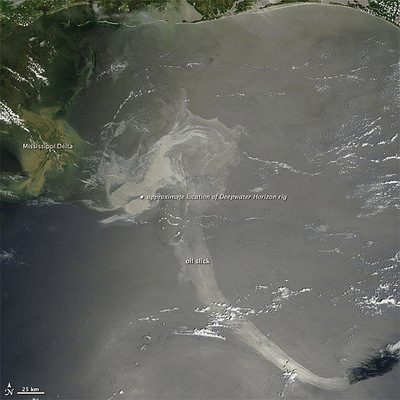
by Carolyn Gramling Thursday, January 5, 2012

The oil spill in late May 2010. NASA
BP’s new cap system, installed to stop the oil spilling into the Gulf, is now working, BP announced this week, though how long it will hold remains to be seen. The cap — which was itself leaking until robotic submersibles finally stemmed the new leak yesterday afternoon — is not intended to be a permanent fix; BP is currently drilling two relief wells that it plans to use to pump mud and cement into the well and hopefully permanently plug it by mid-August.
But what about the oil already in the Gulf? Its long-term fate is still in question — but scientists at the University of Hawaii have put together a simulation that tracks the possible fate of 5 billion buoyant oil particles released into the Gulf over 150 days (from April 20, the date of the oil rig explosion that caused the leak, until mid-September — an end date that may or may not be overly pessimistic, depending on whether the current cap continues to hold). The computer animation, which you can watch on YouTube, follows the path of the particles over the course of about a year, based on projections of ocean circulation.
The scientists estimated the flow of oil at about 50,000 barrels per day, near the upper end of the most recent estimate of the rate of oil gushing into the Gulf. The projection is grim enough: At first, these buoyant particles (meaning those that stay at the surface and follow surface currents, rather than any in a deeper plume) fill the Gulf. By day 100 or so (for perspective, we're now at day 87), the oil enters the Loop Current and the narrow Florida Current, which propels it quickly around the tip of Florida and into the Gulf Stream. While some of the oil may wash up on Carolina beaches this October, much of the oil will ultimately be carted toward Europe, according to the simulation. By the end of a year, the simulations suggest, as much as 20 percent of the buoyant oil particles will likely have traveled halfway across the North Atlantic Ocean.
But that’s only part of the story. It’s worth noting that much of the oil spill isn’t actually composed of these buoyant particles; scientists have found evidence of deepwater plumes of oil in the Gulf. And on the other hand, the model also doesn’t include the fate of oil affected by chemical dispersants or by microbial degradation. How well microbes in the Gulf can degrade different compounds in crude oil is an open question — and how the microbes in the Gulf will respond to the combination of crude oil and dispersants is even more uncertain. Those are questions that a number of researchers, including David Valentine of the University of California at Santa Barbara and Samantha Joye of the University of Georgia, are currently investigating. (By the way, I highly recommend reading Samantha Joye’s Gulfblog, linked above, for more in-depth and in-the-field information on researching oxygen depletion conditions in the Gulf, looking for chemical fingerprints of the oil, the presence of oil-associated pollutants such as volatile organic compounds and polycyclic aromatic hydrocarbons, and other ongoing questions.)
At nearly 90 days since the blowout, NOAA overflights and remote sensing data show that the oil is still moving south-southeast in the Gulf; some may have already moved into the Loop Current, although this is not yet clear. And what will happen if a major hurricane passes over the spill is also unclear: Will the resulting sea spray and evaporated water carry a significant amount of oily residue — as well as those pollutants and chemical dispersants — to the shore? Models aside, only time will tell what happens next.
© 2008-2021. All rights reserved. Any copying, redistribution or retransmission of any of the contents of this service without the expressed written permission of the American Geosciences Institute is expressly prohibited. Click here for all copyright requests.